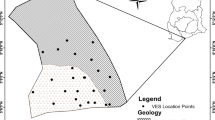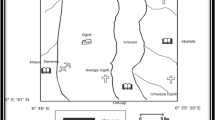Abstract
Integrated geoelectrical and hydrochemical surveys were used to investigate and delineate different types of groundwater in the Kuala Selangor alluvial aquifer. Previous hydrogeological borehole investigation showed that this aquifer contains several types of groundwater in relation to its salinity. The high salinity of the groundwater in some areas is believed to be due to either saltwater intrusion from the nearby sea or river infiltration during high tide season. The vertical electrical sounding (VES) method was employed to study and map the subsurface variation of resistivity in the area. For each sounding measurement, a total spread length of 300 m was obtained with a vertical depth penetration of about 60 to 75 m. Chemical analysis of the groundwater samples taken from both shallow and deep boreholes was carried out for the water quality determination. A total of 45 VES stations were succesfully established along three parallel roads with a direction almost perpendicular to the coastal line. The distance between stations varies from 1 to 2 km with a maximum length of about 60 km surveyed line. Results of the vertical electrical soundings as well as the hydrochemistry of the groundwater samples show that the soil and groundwater in the study area can be grouped into fresh and brackish water zones. The subsurface resisitivity sections derived from the VES study suggest that the area is dominated by brackish soil and groundwater zones, especially in the area towards the coast. This result appears to agree well with the groundwater pumped from boreholes scattered around in the area. Water drawn from boreholes near the coast showed higher salinity compared to the water pumped from inland boreholes. Chloride values greater than 250 mg/L are considered to represent the brackish zones whilst values less than 250 mg/L represents zones of fresh soil and groundwater.









Similar content being viewed by others
References
APHA, AWWA, WPCF (1995) Standard methods for the examination of water and wastewater, 19th edn. American Public Health Association, Washington
Archie GE (1942) The electrical resistivity log as an aid in determining some reservoir characteristics, AIME Tech. Paper 1422
Bachik AR (2000) Groundwater potential in Kuala Selangor-Batang Berjuntai Selangor. Geological Survey Dept report
Bugg SF, Lloyd JW (1976) A study of freshwater lense configuration in the Cayman Islands using resistivity methods. Q J Eng Geol 9:291–302
Choudhury K, Saha DK, Chakraborty P (2001) Geophysical study for saline water intrusion in a coastal alluivial terrain. J Appl Geophys 46:189–200
Fetter CW (2001) Applied hydrogeology. Prentice Hall Inc., New Jersey
Frohlich RK, Urish D (2002) The use of geoelectrics and test wells for the assessment of groundwater quality of a coastal industrial site. J Appl Geophys 50:261–278
Inman JR (1975) Resitivity inversion with ridge regression. Geophysics 40:798–817
Interpex Limited (1990) Resix user’s manual of DC Resistivity Data Interpretation software. Golden, Colorado
Jackson PN, Taylor SD, Stanford PN (1978) Resistivity-porosity–particle shape relationship for marine sands. Geophysics 43:1250–1268
Johnston RH (1983) The saltwater-freshwater interface in the Tertiary limestone aquifer, southeast Atlantic outer-continental shelf of the USA. J Hydrol 61:239–249
Kaya GK (2001) Investigation of groundwater contamination using electric and electromagnetic methods at an open waste-disposal site: a case study from Isparta, Turkey. Environ Geol 40:725–731
Keller GV, Frischknecht FC (1977) Electrical methods in geophysical prospecting. Pergamon Press, Oxford
Kelly EW (1976) Geoelectric sounding for delineating groundwater contamination. Groundwater 14:6–11
Koefoed O (1979) Resistivity soundings measurements. In:Geosounding principles, vol. 1, Elsevier, New York
Lashkaripour GR (2003) An investigation of groundwater condition by geoelectrical resistivity method: a case study in Korin aquifer, Southeast Iran. J Spat Hydrol 13(1):1–5
Nigmatullin RR, Dissado LA, Sontougin NN (1992) A fractal pore model for Archie’s Law in sedimentary rock. J Phys D Appl Phys 25:32–37
Rafek AG, Samsudin AR (1989) Pemetaan lapisan lempung samudera dengan kaedah keberintangan geoelectrik di kawasan lebuh raya Tangkak—Pagoh, Johor. Sains Malaysiana 18(1):139–148
Rhoades JD (1982) Reclamation and management of salt-affected soils after drainage. Proc. First annual western provincial conf. rationalization of water and soil resources and management. Lethbridge, Alberta pp 123–197
Samsudin AR, Haryono, Hamzah U, Rafek AG (1997) Salinity study of coastal groundwater aquifers in North Kelantan, Malaysia. Geol Soc Malaysia Bull 41:159–165
Surip N (1994) Penggunaan kaedah-kaedah geofizik, hidrogeologi dan radioisotop dalam mengesan akuifer air masin kawasan Kuala Rompin dan Marang. Unpublished MSc theses National University of Malaysia
Sapari N, Awang MN (1996) Alluvial aquifer in Selangor: a threatened water resources. Prosiding Seminar Geologi dan Sekitaran: Impak dan Pengauditan. UKM, Bangi 85–101
Stauffer PH (1973) Quaternary deposits. In: Gobbett DJ, Hutchison CS (eds) Geology of The Malay Peninsula. Wiley, New York pp438
Urish DW, Frohlich RK (1990) Surface electrical resistivity in coastal groundwater exploration. Geoexplor 26:267–289
Wetzel RG, Likens GE (1991) Limnological analysis. Springer, Berlin Heidelberg New York p 391
Young ME, de Brujin RGM, Salim AA (1998) Exploration of an alluivial aquifer in Oman by time-domain electromagnetic sounding. Hydrogeol J 6:383–393
Zohdy AAR, Bisdorf RJ (1989) Programs for the automatic processing and interpretation of Schlumberger sounding curves in quick basic. U.S. Geological Survey Open File Report89–137–2, 64 p
Acknowledgments
We would like to thank members of UKM Geophysical Group for their cooperation in the geophysical field data collection and help in processing some of the data. We also wish to thank the Department of Mineral and Geoscience of Malaysia for providing borehole data used for the interpretation and finally the Malaysian Ministry of Science, Technology & Innovations for financing this project through RM7 (02-02-02-010) R&D project.
Author information
Authors and Affiliations
Corresponding author
Rights and permissions
About this article
Cite this article
Hamzah, U., Samsudin, A.R. & Malim, E.P. Groundwater investigation in Kuala Selangor using vertical electrical sounding (VES) surveys. Environ Geol 51, 1349–1359 (2007). https://doi.org/10.1007/s00254-006-0433-8
Received:
Accepted:
Published:
Issue Date:
DOI: https://doi.org/10.1007/s00254-006-0433-8




